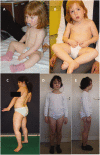ISPD gene mutations are a common cause of congenital and limb-girdle muscular dystrophies
- PMID: 23288328
- PMCID: PMC3562076
- DOI: 10.1093/brain/aws312
ISPD gene mutations are a common cause of congenital and limb-girdle muscular dystrophies
Abstract
Dystroglycanopathies are a clinically and genetically diverse group of recessively inherited conditions ranging from the most severe of the congenital muscular dystrophies, Walker-Warburg syndrome, to mild forms of adult-onset limb-girdle muscular dystrophy. Their hallmark is a reduction in the functional glycosylation of α-dystroglycan, which can be detected in muscle biopsies. An important part of this glycosylation is a unique O-mannosylation, essential for the interaction of α-dystroglycan with extracellular matrix proteins such as laminin-α2. Mutations in eight genes coding for proteins in the glycosylation pathway are responsible for ∼50% of dystroglycanopathy cases. Despite multiple efforts using traditional positional cloning, the causative genes for unsolved dystroglycanopathy cases have escaped discovery for several years. In a recent collaborative study, we discovered that loss-of-function recessive mutations in a novel gene, called isoprenoid synthase domain containing (ISPD), are a relatively common cause of Walker-Warburg syndrome. In this article, we report the involvement of the ISPD gene in milder dystroglycanopathy phenotypes ranging from congenital muscular dystrophy to limb-girdle muscular dystrophy and identified allelic ISPD variants in nine cases belonging to seven families. In two ambulant cases, there was evidence of structural brain involvement, whereas in seven, the clinical manifestation was restricted to a dystrophic skeletal muscle phenotype. Although the function of ISPD in mammals is not yet known, mutations in this gene clearly lead to a reduction in the functional glycosylation of α-dystroglycan, which not only causes the severe Walker-Warburg syndrome but is also a common cause of the milder forms of dystroglycanopathy.
Figures





Similar articles
-
Refining genotype phenotype correlations in muscular dystrophies with defective glycosylation of dystroglycan.Brain. 2007 Oct;130(Pt 10):2725-35. doi: 10.1093/brain/awm212. Epub 2007 Sep 18. Brain. 2007. PMID: 17878207
-
A novel homozygous ISPD gene mutation causing phenotype variability in a consanguineous family.Neuromuscul Disord. 2015 Jan;25(1):55-9. doi: 10.1016/j.nmd.2014.08.007. Epub 2014 Sep 10. Neuromuscul Disord. 2015. PMID: 25444434
-
A fourth case of POMT2-related limb girdle muscle dystrophy with mild reduction of α-dystroglycan glycosylation.Eur J Paediatr Neurol. 2014 May;18(3):404-8. doi: 10.1016/j.ejpn.2013.10.005. Epub 2013 Oct 27. Eur J Paediatr Neurol. 2014. PMID: 24183756
-
Telethonin-deficiency initially presenting as a congenital muscular dystrophy.Neuromuscul Disord. 2011 Jun;21(6):433-8. doi: 10.1016/j.nmd.2011.03.005. Epub 2011 May 6. Neuromuscul Disord. 2011. PMID: 21530252 Review.
-
[Fukuyama congenital muscular dystrophy and related alpha-dystroglycanopathies].Brain Nerve. 2008 Oct;60(10):1159-64. Brain Nerve. 2008. PMID: 18975603 Review. Japanese.
Cited by
-
N-terminal domain on dystroglycan enables LARGE1 to extend matriglycan on α-dystroglycan and prevents muscular dystrophy.Elife. 2023 Feb 1;12:e82811. doi: 10.7554/eLife.82811. Elife. 2023. PMID: 36723429 Free PMC article.
-
Genetic cause of heterogeneous inherited myopathies in a cohort of Greek patients.Mol Genet Metab Rep. 2020 Nov 30;25:100682. doi: 10.1016/j.ymgmr.2020.100682. eCollection 2020 Dec. Mol Genet Metab Rep. 2020. PMID: 33304817 Free PMC article.
-
Systematic Selection Signature Analysis of Chinese Gamecocks Based on Genomic and Transcriptomic Data.Int J Mol Sci. 2023 Mar 20;24(6):5868. doi: 10.3390/ijms24065868. Int J Mol Sci. 2023. PMID: 36982941 Free PMC article.
-
Mutations in B3GALNT2 cause congenital muscular dystrophy and hypoglycosylation of α-dystroglycan.Am J Hum Genet. 2013 Mar 7;92(3):354-65. doi: 10.1016/j.ajhg.2013.01.016. Epub 2013 Feb 28. Am J Hum Genet. 2013. PMID: 23453667 Free PMC article.
-
Prenatal muscle development in a mouse model for the secondary dystroglycanopathies.Skelet Muscle. 2016 Feb 19;6:3. doi: 10.1186/s13395-016-0073-y. eCollection 2016. Skelet Muscle. 2016. PMID: 26900448 Free PMC article.
References
-
- Bonnemann CG, Finkel RS. Sarcolemmal proteins and the spectrum of limb-girdle muscular dystrophies. Semin Pediatr Neurol. 2002;9:81–99. - PubMed
-
- Bourteel H, Vermersch P, Cuisset JM, Maurage CA, Laforet P, Richard P, et al. Clinical and mutational spectrum of limb-girdle muscular dystrophy type 2I in 11 French patients. Journal of neurology, neurosurgery, and psychiatry. 2009;80:1405–8. - PubMed
-
- Breton C, Snajdrova L, Jeanneau C, Koca J, Imberty A. Structures and mechanisms of glycosyltransferases. Glycobiology. 2006;16:29R–37R. - PubMed
Publication types
MeSH terms
Substances
Grants and funding
LinkOut - more resources
Full Text Sources
Other Literature Sources
Medical
Molecular Biology Databases
Research Materials

